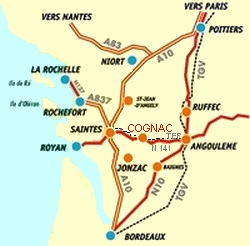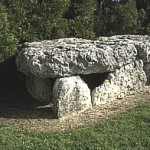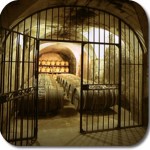So you think that Cognac is only the name of a famous brandy? Think again. The town of Cognac, located north of Bordeaux and southwest of Paris in the “Charentes” department, dates back to prehistoric times some 2400 to 1800 years before the birth of Jesus Christ, as evidenced by its famous dolmen of Sèchebec.
A twenty-mile area called the ‘golden circle” of cognac production encompasses Cognac and the second distilling town of Jarnac. The entire region comprises of six areas: La Grande Champagne, La Petite Champagne, Les Borderies, Les Fins Bois, Les Bons Bois and Les Bois Ordinaires or “à terroir”.
Its strategic location on the slow-moving Charente River allowed it to develop commerce beginning in the Middle Ages, notably salt and then gradually, its wine. In the 17th century, under Louis XIV. the commerce that developed is referred to as Cognac’s production of “eaux-de-vie”, its renowned brandy industry. (For those curious Francophiles, the term “eaux-de-vie” literally translates to “the waters of life”, lending to its importance and how well-loved cognac is around the world).
A special white grape (the “ugni blanc”) is used to produce cognac. It is first produced as wine, and then it goes through a second distillation, through the famous stills of the Charentes. Only after this distillation does the wine turn into cognac. It will then age in oak barrels for at least 2½ years. At that time, the cognac is then ready for market sale.
There are three main categories for cognac. Each category is defined based on the growth area of the grape, and the blending of the “eaux-de-vie” of various ages. The first category is V.S. (also denoted as ***), which indicates that the “eaux-de-vie” in the blend has aged for the minimum 2½ years. The second category is V.S.O.P.- 4½ years for Very Superior Old Pale. Lastly, the third category is Napoléon, or X.O.- 6½ years.
Cognac’s distinction from other alcohol depends on the following four conditions: the vines (unique to the Charentes region), the double distillation technique, the ageing process, and the highly coveted “blending” techniques, handed down from generation to generation. In the ageing process, the oak used is specific from the Limousin or Tronçais forests. It is the tannins that are passed on from the oak to the alcohol which give cognac its distinctive color and “bouquet”.
It is no small wonder that Cognac is world-renowned for this famous libation. Cognac comes in many different varieties and flavors, and it may be served in various ways. A visit to Cognac is a delightful lesson in understanding its most famous export! Continue learning by reading more about Cognac.


